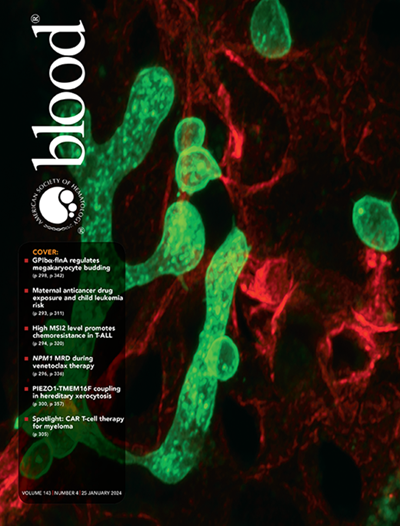全基因组分析定义了MPN亚型的遗传决定因素,并确定了CDH22/CD40的性别特异性关联。
IF 23.1
1区 医学
Q1 HEMATOLOGY
引用次数: 0
摘要
为了确定影响骨髓增殖性肿瘤(MPN)表型的遗传变异,我们采用来自英国(包括英国生物银行)、西班牙、德国和意大利的队列进行了一项两阶段的病例全基因组关联研究。MPN亚型[原发性血小板增多症(ET);真性红细胞增多症(PV)与健康对照进行比较,并根据染色体9p畸变、JAK2 V617F突变负担和性别进行分层分析。ET与PV分析确定了已知的关联:(i) HBS1L-MYB增加ET风险(PMETA=7.93 × 10-6, OR=1.28),降低PV风险(PMETA=9.43 × 10-5, OR=0.81); (ii) GFI1B-GTF3C5只倾向于PV (PMETA=1.43 × 10-9, OR=1.38)。另外两个cd22 /CD40位点的内含子snp rs2425786和rs2425788仅在女性中显著(PMETA=2.67 × 10-8),具有PV易感性(PMETA=0.0006, OR=1.3)和ET风险降低(PMETA=7.82 × 10-5, OR=0.75)。证实与JAK2、TERT、ATM、TET2、PINT、GFI1B和SH2B3相关(PMETA<5 × 10-8),另外9个基因座被复制(PMETA<0.05)。由来自31个位点的48个snp组成的多基因风险评分对ET和PV表现出中等的区分能力(AUC=0.718),并通过优化疾病亚型(AUCET=0.724和AUCPV=0.755)得到改善。总体而言,我们的研究结果表明,多种种系变异影响MPN表型,其中HBS1L-MYB和与CDH22/CD40的新型性别特异性关联是最强的决定因素。本文章由计算机程序翻译,如有差异,请以英文原文为准。
Genome-wide analysis defines genetic determinants of MPN subtypes and identifies a sex-specific association at CDH22/CD40.
To identify genetic variants that influence myeloproliferative neoplasm (MPN) phenotype, we undertook a two-stage case-only genome-wide association study using cohorts from the UK (including UK Biobank), Spain, Germany and Italy. MPN subtype [essential thrombocythemia (ET); polycythemia vera (PV)] were compared to each other, to healthy controls and stratified analyses was performed based on chromosome 9p aberrations, JAK2 V617F mutation burden and sex. The ET versus PV analysis identified known associations: (i) at HBS1L-MYB that increased ET risk (PMETA=7.93x10-6, OR=1.28) and reduced PV risk (PMETA=9.43x10-5, OR=0.81) and (ii) at GFI1B-GTF3C5 that predisposed to PV only (PMETA=1.43x10-9, OR=1.38). Two further linked intronic SNPs, rs2425786 and rs2425788, at CDH22/CD40 were significant in females only (PMETA=2.67x10-8) with predisposition to PV (PMETA=0.0006, OR=1.3) and reduction of ET risk (PMETA=7.82x10-5, OR=0.75). Associations with JAK2, TERT, ATM, TET2, PINT, GFI1B and SH2B3 were confirmed (PMETA<5x10-8) and nine further loci were replicated (PMETA<0.05). A polygenic risk score consisting of 48 SNPs from 31 loci demonstrated moderate discriminative performance for ET and PV (AUC=0.718) and was improved by optimization for disease subtype (AUCET=0.724 and AUCPV=0.755). Overall, our results reveal that multiple germline variants influence MPN phenotype with HBS1L-MYB and a novel sex-specific association with CDH22/CD40 being the strongest determinants.
求助全文
通过发布文献求助,成功后即可免费获取论文全文。
去求助
来源期刊

Blood
医学-血液学
CiteScore
23.60
自引率
3.90%
发文量
955
审稿时长
1 months
期刊介绍:
Blood, the official journal of the American Society of Hematology, published online and in print, provides an international forum for the publication of original articles describing basic laboratory, translational, and clinical investigations in hematology. Primary research articles will be published under the following scientific categories: Clinical Trials and Observations; Gene Therapy; Hematopoiesis and Stem Cells; Immunobiology and Immunotherapy scope; Myeloid Neoplasia; Lymphoid Neoplasia; Phagocytes, Granulocytes and Myelopoiesis; Platelets and Thrombopoiesis; Red Cells, Iron and Erythropoiesis; Thrombosis and Hemostasis; Transfusion Medicine; Transplantation; and Vascular Biology. Papers can be listed under more than one category as appropriate.
 求助内容:
求助内容: 应助结果提醒方式:
应助结果提醒方式:


